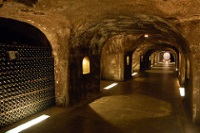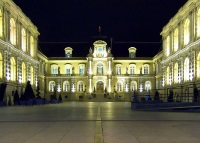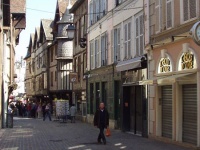Things to do in Champagne Country
Unsurprisingly, the most popular thing to do in Champagne Country is drink champagne. However, the region has plenty to offer visitors and the attractions are varied. Champagne Country is interesting from a military history perspective and has many military monuments, museums and battlefields. Despite heavy bombing of the cities during World War II, there is also still some quality medieval architecture to be found.
Tourists should head for Epernay and Reims to sample the best bubbly on offer in the region. Epernay hosts many of the great champagne houses and visitors can tour the cellars of both Moët et Chandon and Mercier. In Reims the Maison de Pommery, Mumm and Veuve Clicquot, among others, wait to entertain guests. Both of these cities, though ancient, have suffered from wartime destruction and now seem industrial and modern. They do have some gems for the historical sightseer, though, such as the magnificent Cathedrale Notre-Dame de Reims, where dynasties of French monarchs were crowned.
The quaint and well-preserved old town of Troyes, which dates back to the Roman era, gives visitors an idea of how the grand cities of the region must once have looked. It is jam-packed with picturesque old buildings and interesting museums, as well as several incredible churches.
Amiens is a good base from which to explore the battlefields, cemeteries and memorials of World War I. Possibly the best place from which to explore battle sites in the Champagne Country is the industrial town of Chateau-Thierry, where the surrounding countryside has borne witness to great battles during both world wars. Here visitors can explore the WWI Aisne-Marne American Cemetery and the Belleau Wood battlefield, among other moving sites.

Epernay
Epernay, along with Reims, is one of the great centres of champagne production. Dug into the chalk beneath the town are more than 200 miles (322km) of cellars and tunnels containin…
Epernay
Epernay, along with Reims, is one of the great centres of champagne production. Dug into the chalk beneath the town are more than 200 miles (322km) of cellars and tunnels containing champagne from the surrounding area, including such great brands as Moët et Chandon, Pol Roger, Mercier, and de Castellane. Sadly, as Epernay did not fare well in several wars over the centuries, few old buildings remain in the town despite its rich history. In the central and oldest quarter of the town, the streets are narrow and irregular and one can feel the age of the place, but apart from one church that retains some features from the 16th century, the buildings are modern.
Generally the surrounding suburbs are modern and spacious but the many opulent villas belonging to rich wine merchants lend an air of sophistication to the town. However, the main reason people flock to Epernay is to visit the great champagne houses and the lack of ancient architecture doesn't deter many. Both Moët et Chandon, the world's largest producer of bubbly, and Mercier give guided tours of their cellars, in English, throughout the day. They are situated near each other on Avenue de Champagne. Castellane also has daily tours from March to December.
Travellers can also fly over the vineyards in a hot air balloon and enjoy a glass of champagne while they're up there. It's best to go up between May and September to see the vineyards at their greenest.
Reims
A visitor's first impression of Reims (pronounced Rhance) is of a sprawling industrial town peppered with concrete apartment blocks, the result of World War I bombs and later disas…
Reims
A visitor's first impression of Reims (pronounced Rhance) is of a sprawling industrial town peppered with concrete apartment blocks, the result of World War I bombs and later disastrous town planning. However, Reims is an ancient Roman city and the birthplace of the French nation; it contains one of the most impressive Gothic cathedrals in France, the Cathédrale Notre-Dame de Reims, where dynasties of French monarchs were crowned starting with Clovis, first king of the Franks. The neighbouring Basilique St-Rémi is even older and, half Gothic, half Romanesque in style, includes the old royal abbey that is now a museum documenting the history of the town.
Most visitors come to Reims not so much for history but for the hedonistic pleasure of visiting the cellars of its great champagne producers. This is the home of the world's best bubbly. The best of the best is to be sampled at the Maison de Pommery, which has more than 10 miles (16km) of tunnels extending 100ft (30m) down into the chalk below its Gothic superstructure. Travellers can then move on to Mumm, which contains 25 million bottles of slowly fermenting champagne in its vaults, and then Taittinger and Veuve Clicquot. All offer a guided tour of the cellars and champagne making process, followed by a tasting.
Foodies should not miss the opportunity to sample the elegant local cuisine, which can be paired with champagne. Reims ham, truffles, a variety of cheeses, Reims mustard and the light, crunchy, vanilla-flavoured pink biscuits are among the must-try items on offer.
Château-Thierry
Château-Thierry is an industrial town 55 miles (89km) east of Paris on the River Marne. The surrounding countryside was the site of many great battles during both World Wars and a…
Château-Thierry
Château-Thierry is an industrial town 55 miles (89km) east of Paris on the River Marne. The surrounding countryside was the site of many great battles during both World Wars and a number of monuments and cemeteries mark the bravery of thousands of Allied soldiers who fought to liberate France and, who now lie interred under her soil. One of the most popular and rewarding memorial sites for tourists is the WW1 Marine Memorial at Belleau Wood, which is located by the WW1 Aisne-Marne American Cemetery and the Belleau Wood battlefield. The Chateau-Thierry Monument is a good place to start when investigating the military history of the area as it lists the units that fought in the region as well as providing a battle map and orientation table.
The town is also known as the home of the famous poet and fable writer Jean de la Fontaine (1621-95); the Musée Jean-de-la-Fontaine is one of the most popular literary museums in the world and contains a collection of his personal effects, memorabilia and a number of editions of his works. Travellers can visit the Walt Disney Studio in Chateau-Thierry too, where they can explore the behind-the-scenes production world of movies and television. Unfortunately, the chateau that gave the place its name has long been destroyed and very little remains of the old part of the town.

Amiens
Amiens is the ancient capital of Picardy and lies on the River Somme, 75 miles (121km) north of Paris and 65 miles (105km) south of Calais. Walking around the maze of narrow street…
Amiens
Amiens is the ancient capital of Picardy and lies on the River Somme, 75 miles (121km) north of Paris and 65 miles (105km) south of Calais. Walking around the maze of narrow streets, divided by canals, visitors may feel that this is a city past its prime; nevertheless, there are definitely a couple of sites worth exploring.
The city's centrepiece is the Gothic cathedral, built between 1220 and 1270, which is one of the finest in France. The interior contains wonderful examples of medieval masonry and woodwork; 126 slender pillars hold up the vast structure and the stalls are decorated with thousands of carved figures. Like most great churches it has been added to and restored over the centuries.
The nearby Musée de Picardie displays the history and art of the region from prehistoric times through to the present day, along with exhibits from the Roman, Greek and Egyptian empires. The art collection includes European paintings and sculptures from the 16th century, including works by El Greco, Fragonard, Guardi, and Tiepolo. As Amiens also played a vital role in the First World War, there is plenty of military history to explore in the area, including some significant and famous battlefields, cemeteries, German bunkers, a battlefield park and a museum.

Troyes
Those who are tired of fighting off the summer crowds in Champagne Country will find a refreshing alternative in the quaint old town of Troyes, which is a little off the tourist tr…
Troyes
Those who are tired of fighting off the summer crowds in Champagne Country will find a refreshing alternative in the quaint old town of Troyes, which is a little off the tourist track and is full of genuine French appeal. Troyes has been settled since the Roman era and has a rich history, along with many interesting museums and old churches to visit. In the beautifully restored city centre of quaint narrow streets, Renaissance mansions and pretty old houses stands one of France's most magnificent Gothic cathedrals.
Troyes was lucky to avoid destruction during war, which is partly why it has so many historic buildings still standing; apart from the magnificent Saint-Pierre-et-Saint-Paul Cathedral, visitors should look out for other worthwhile old churches including Saint-Nizier Church, which has remarkable sculptures, the 13th-century Saint-Urbain Basilica, and Saint-Nicolas Church, a Gothic building dating back to the early 16th century.
Strolling around the old part of town is one of the primary delights of Troyes, and there are numerous good restaurants and cafes. The city also boasts a private collection of art housed in the old bishop's palace, the Musée d'Art Moderne, which displays works by Bonnard, Degas and Gauguin.



